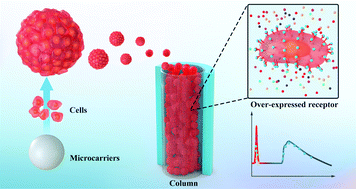Cell-based 3D bionic screening by mimicking the drug–receptor interaction environment in vivo†
Abstract
Most small-molecule drugs influence cell behavior through their interaction with one or more cellular proteins. The efficacy is unanticipated in the later stages of drug development if small-molecule drugs are discovered in the absence of a biological context. Bionic screening is an in vivo drug–receptor interaction platform that can identify small molecules with recognized activity, improving the likelihood of drug efficacy in the clinic. Here, we report the design of an innovative cell-based bionic screening system using 3D microcarrier cultures to simulate in vivo conditions and facilitate small-molecule drug discovery. Through its combination with HPLC/MS, the method can comprehensively identify small-molecule lead compounds in arbitrarily complex systems in an unbiased manner. In particular, cell-covered microcarriers provide a high-density of cells for affinity performance assessments in the absence of appreciable cell damage and maintain immunogenicity, the 3D structure of which is similar to tissue morphology in vivo, thereby mimicking in vivo drug–receptor interactions. The method is scalable, easy to handle, and requires minimal optimization across a range of different cell lines to realize high-throughput drug screening for the corresponding diseases. This provides a valuable tool for lead compound discovery in more physiologically relevant systems and may address the lack of clinically available drugs.



 Please wait while we load your content...
Please wait while we load your content...